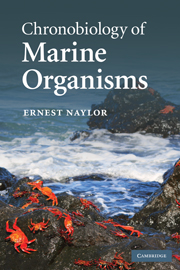Book contents
- Frontmatter
- Contents
- Preface
- 1 Moonshine
- 2 Biorhythms of coastal organisms
- 3 Tidal and daily time-cues
- 4 Clocks and compasses
- 5 Lunar and semilunar biorhythms
- 6 Annual biorhythms
- 7 Plankton vertical migration rhythms
- 8 Staying put in estuaries
- 9 Ocean drifters
- 10 Living clockwork
- References
- Author index
- Subject index
- Plate section
9 - Ocean drifters
Published online by Cambridge University Press: 05 June 2012
- Frontmatter
- Contents
- Preface
- 1 Moonshine
- 2 Biorhythms of coastal organisms
- 3 Tidal and daily time-cues
- 4 Clocks and compasses
- 5 Lunar and semilunar biorhythms
- 6 Annual biorhythms
- 7 Plankton vertical migration rhythms
- 8 Staying put in estuaries
- 9 Ocean drifters
- 10 Living clockwork
- References
- Author index
- Subject index
- Plate section
Summary
Animal plankton [comprises] small, free-swimming animals whose powers of swimming are not great enough to overcome the transporting effects of currents and tides.
John S. Colman, 1950Assemblages of organisms in the sea are commonly and very broadly classified according to their way of life. Sea floor burrowers, crawlers and fixed forms comprise the benthos, strong swimmers such as fish, mammals and squid are designated as nekton, and the poor swimmers as plankton. The last group, named from the Greek verb to wander, roam or drift, is a particularly heterogeneous assemblage of living organisms ranging from prokaryotic cyanobacteria (so-called blue-green algae) and true unicellular microalgae to large coelenterates, often including the eggs and larvae of benthic invertebrates and of fish. The swimming powers of animals within this motley group are weak, testified by the mass stranding of coelenterates and other plankton species that are often found along coastlines after a spell of onshore winds at certain times of year. Consistent with the view that the swimming powers of planktonic animals are not great enough to overcome ocean currents (Colman, 1950), many early marine biological studies that focussed on the distribution and spread of benthic species, did so on the assumption that their planktonic larvae dispersed passively in ocean surface currents (see Thorson, 1964; Scheltema, 1971). This was not an unreasonable assumption since dispersal benefits encroachment of new localities by distributive larvae, as has recently been quantified by studies of the free-swimming planktonic larvae of shore-living fishes in the Mediterranean Sea.
- Type
- Chapter
- Information
- Chronobiology of Marine Organisms , pp. 166 - 180Publisher: Cambridge University PressPrint publication year: 2010



